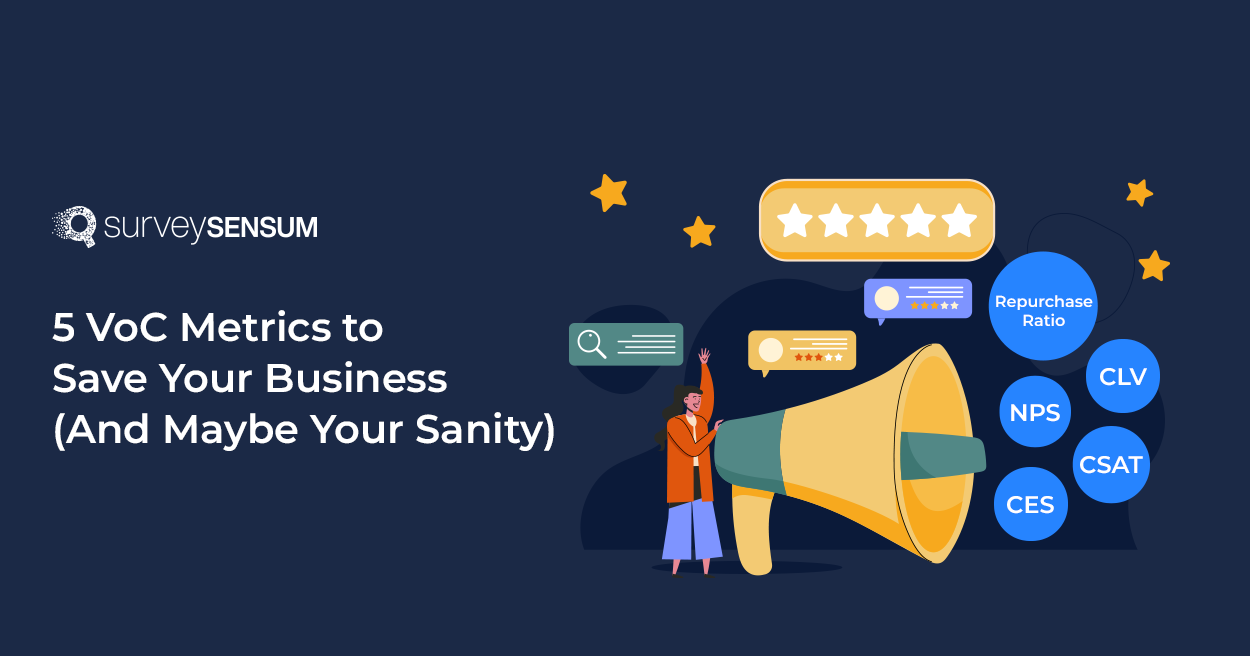
US enterprises lose $83 billion in sales every year due to poor customer experience.
We are talking about billions here!
The solution here – Listen to the Voice of the Customer.
By listening to the voice of the customers, businesses can listen to, understand, and meet customers’ growing expectations. Today’s customer marketing landscape is not a one-way dialogue anymore. Market leaders MUST listen to what customers have to say.
And a lucrative VoC program is the key to it. It gives insights into customers pain points and preference, enabling businesses to create and improve the product as per customer dements. IF done right, it directly improves customer satisfaction and loyalty.
By leveraging VoC metrics, you can gauge customer satisfaction, loyalty, their intent, and their plans in the near future. Doing this across the customer journey, you can identify the touchpoints with the most friction and make better, impactful decisions.
But there are multiple Voice of the Customer metrics out there – which one should you pick? Let’s find out.
5 Voice of the Customer Metrics You Should Look Out For
1. NPS
Net Promoter Score or say NPS helps you gauge customer loyalty by asking one simple question –
→ On a scale of 0-10, how likely are you to recommend us [brand/product/service] to your friends and acquaintances?
Based on the responses, the respondents are bifurcated into three categories.
- Promoters: They are the happiest and loyal customers who give a score of 9 or 10. They are the ones who are ready to become your brand advocates and refer you to other prospects.
- Passives: They are the ones who are not unhappy with your product or service but aren’t happy either. They give you a score of 7 to 8. They are merely satisfied, but can switch their loyalty any time for better pricing, service, or value. You can easily convert them into promoters by listening to their feedback and giving them exactly what they want.
- Detractors: They give you a score between 0 to 6. These customers are the unhappiest ones and they are most likely to churn if no actions are taken in time to address their issues.
NPS surveys are ideally launched quarterly, biannually, or annually. However, it is recommended to track it regularly in order to identify if the actions taken have a desired impact on customer satisfaction or not.
2. CSAT
Customer Satisfaction Score or CSAT score helps you understand if customers are satisfied with a particular interaction, transaction, product, or service (and yes, the overall brand). It asks a simple CSAT question –
→ On a scale of 1-5, how satisfied are you with [product, service, brand?]
The CSAT scale can vary from 1-5, 1-7, or 1-10 where 1 is most unsatisfied and high number is most satisfied.
There are ways to scale on CSAT questions that you can use – emoticons, stars, etc.
When to launch a CSAT Survey?
The right time to send a CSAT survey is after a particular transaction or interaction. For instance, after a product delivery, post customer service, post webinar, etc.
Start gauging customer satisfaction with CSAT surveys. All you need to do is pick a template and share it forward. Try it for free!
3. CES
Customer Effort Score or CES Score gauges how effortless it is to interact with your business or use of product or service. It asks a simple question (depending on the interaction you gauge).
→ How easy was the payment process?
→ How easy was the website navigation?
It is one of the strongest VoC metrics and helps in predicting the future behavior of the customers. So much so that 94% customers said that they are likely to repurchase from a brand if there is low effort; and 88% would increase their spending.
When to launch a CES Survey?
You should launch a CES survey after key interactions like resolving a customer issue, payment completion, or post onboarding. However, make sure that you launch it JUST after the interaction when the experience is still fresh in their minds.
4. CLV
How much business or say profit is attributed to a customer during their lifetime is called Customer Lifetime Value or CLV. It takes the entire current and future relationship into account enabling businesses to understand the long-term value and allocate resources to each customer accordingly.
How to Calculate CLV?
Customer Lifetime Value can be calculated with this formula:
CLV= (Average Purchase Value*Purchase Frequency)*Customer Lifespan
5. Repurchase Ratio
The repurchase ratio is a VoC metric that gauges the frequency at which current customers made the repurchases in a certain period. It allows businesses to understand how effective their loyalty and retention strategies are.
How to Calculate Repurchase Ratio?
Repurchase Ratio = Number of Returning Customers*Total Number of Customers
Higher the repurchase ratio, better customer loyalty and successful retention effort and vice versa.
Conclusion
It is imperative to understand customer needs and expectations in order to deliver exceptional customer experience. And VoC metrics provide valuable insights to guide your strategy.
As discussed, NPS, CSAT, CES, CLV, and repurchase ratio are the most common and impactful VoC metrics – each of these metrics offer unique insights into customer experience. Businesses must pick one as per their objective and stick to it. It’s crucial to consistently measure the chosen metric in order to observe and improve the impact of actions and strategies taken to boost the respective score.
A robust customer feedback tool like SurveySensum can help you with that. It streamlines the process of gauging VoC metrics, offers features in boosting these numbers, and gives relevant insights to the team to take action that drives growth.
All in all, by prioritizing these VoC metrics you can ensure that you foster a customer-centric culture, be responsive and have a competitive edge in today’s market, and a customer feedback tool can help you with it!















